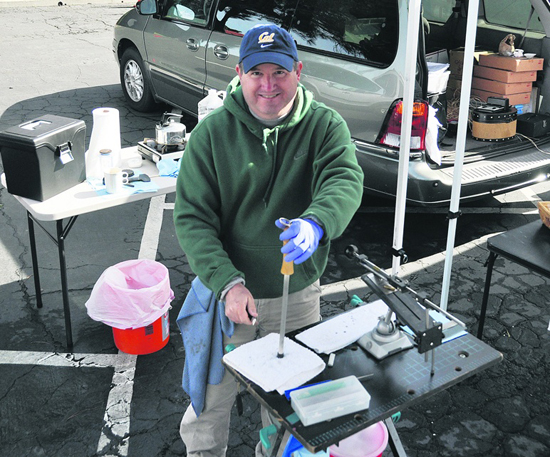
| ||||||
Sharp by Hand is at the Moraga Farmers' Market most Sundays, and can diagnose and correct your knife's problems while you shop the market. Latham can usually sharpen two or three knives while you wait, but if you have an entire set, it's a good idea to leave them with him and return the following week for pick up. It typically takes 10 to 15 minutes per knife, depending up on the size and condition of the knife. He also suggests arriving early, when the market opens (9 a.m.), so he has plenty of time to fit in as many customers as possible before the market shutters at 1 p.m.
Latham started his business when his own kitchen knives were in need of sharpening.
"I looked everywhere to find a good sharpener, but didn't like what I saw," he said. "Most were using belts and sanders or grinding wheels, which I thought to be too aggressive for knives used by the home chef."
After much research, he discovered a custom-made abrasive water stone system, which he calls the "Cadillac" of hand-operated knife sharpening systems.
"It was very expensive, but I bought it anyway," he noted. "I sharpened all of my knives and it did a great job. Then, I moved onto my friends and family and sharpened all of their knives."
When he ran out of knives to sharpen, he decided to branch out and make a business of it-to share his newly honed skill and to capitalize on his investment.
According to Latham, the home sharpening systems such as Chef's Choice don't necessarily have the appropriate angles for all knives and they use a stone with "middle of the road" coarseness, which again may not be appropriate for every knife. And, they often sheer off too much metal with each use.
Chef Lesley Stiles, who owns a Pleasant Hill catering company of the same name, takes her knives to Sharp by Hand on a regular basis.
"Each knife has its own life and its own story to tell," she said. "Each needs personal attention and David does exactly that. I use my knives constantly and the edges last a long time after he's sharpened them. The trait of a good sharpener is if you can use your steel to keep the edge sharp in between visits."
Both Latham and Stiles say their favorite knives are W┼sthof chef knives. David likes the 6-7" blade while Stiles likes her 10" chef's knife. It is largely a matter of what feels comfortable in your hand.
"Spending money on one good quality knife such as a W┼sthof, that could last a lifetime, is a smarter investment than buying a whole set of inferior-quality knives," instructed Latham. "For students or young people going out on their own, Dexter-Russell knives are also a very good value, and they sharpen up very well."
Susan Marconi, manager of Across the Way in Moraga, said she and her dad, Sal Zammitti, have taken their knives to Sharp by Hand and are very pleased with the results.
"The knives had beautiful edges when we picked them up," Marconi said. "There were no rough spots at all. The blades were consistent from tip to handle and they have held their edges very well."
Latham says that there are three things that determine how well an edge will hold: the surface of the cutting board, what is being cut, and how the operator uses it. For example, cutting on glass, ceramic or steel surfaces will dull a knife more quickly than on composite, wood or plastic surfaces. Similarly, if the owner mistreats the knife by tossing it loosely in a drawer, running it through the dishwasher, or using it as a can opener, box cutter or chisel, the life expectancy of the edge and the knife itself will be compromised.
Serrated knives are a different animal all together and should be taken to a specialist who has dedicated machines for this type of blade. They can be hand-sharpened by thinning the flat side of the knife at a very shallow angle and then running a much finer thin, (rattail) file through the scallops, but it is usually best to send them off to a sharpener with a machine designed to re-contour the scallops.
"These knives are real workhorses in the kitchen, but are not well-suited to a lot of sharpening because of the smaller surface area around each contour on the scalloped edge," Latham explained. "And it's expensive, so I suggest sharpening your serrated knives only when absolutely necessary."
Latham and his wife, Annie, enjoy the Sunday morning farmers' market ritual in Moraga.
"It is a really nice community experience," he noted. "I've learned a lot about the area's youth soccer, schools and teachers. It's like an active 'town square' that meets on Sunday mornings!"
Sharp by Hand - David Latham
Phone: (925) 808-9834, Email: sharpbyhand@gmail.com
To learn more about knife sharpening and what to look for, Latham suggests this web site: http://forums.egullet.org/
index.php?//topic/26036-knife-
maintenance-and-sharpening/
Reach the reporter at:
Copyright
